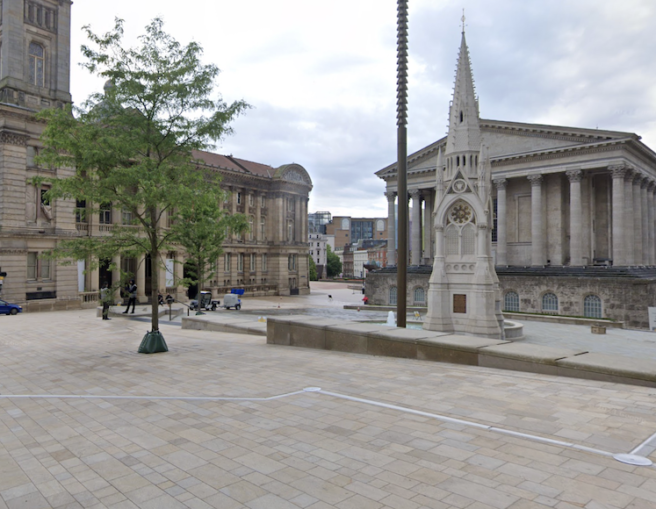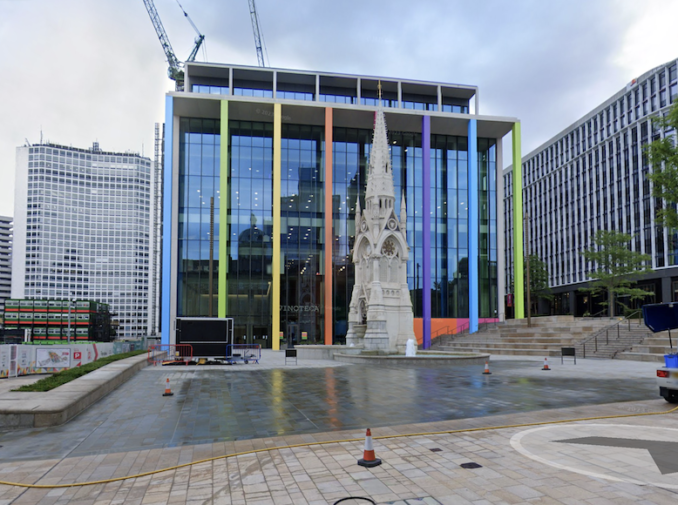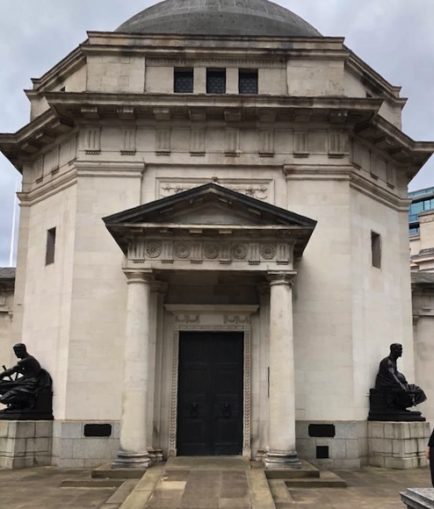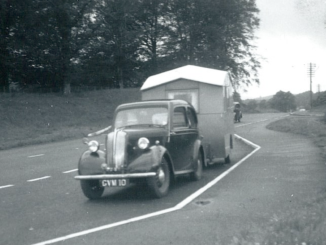Chamberlain Square
Having checked out the Council House and Town Hall during our day trip to Birmingham, myself and Mrs AWS nip around the back and into Chamberlain Square, the centrepiece of which is the Chamberlain Memorial. Surrounded by high buildings, the neo-gothic monument is a deceptive 65 ft tall with its south side carrying a medallion depicting Joseph Chamberlain.
Inaugurated in October 1880 via public subscription this commemorates the exceptional service to Birmingham by Mr Joseph Chamberlain the President of The Board of Trade during his connection with the town council. Originally a monumental fountain, the work was executed in Sicilian marble by Mr Thomas Woolner RA.

© Google Street View 2024, Google.com
Joseph Chamberlain had been elected as a town councillor in 1869, mayor in 1873 and an MP in 1876. Present at the unveiling of his monument, he addressed the crowd noting the importance of municipal institutions for the establishment of good order in the community, and good government in the state.
The Chamberlains
The Chamberlain family, particularly Joseph and his sons, Austen and Neville, played an important role in shaping Birmingham’s history and its development as a major British city. Their influence extended beyond local politics into national and international arenas, with each contributing to Birmingham’s transformation during the late 19th and early 20th centuries.
Joseph, once referred to as the “father of modern Birmingham,” moved to the city in 1854 from London. Initially involved in the screw-making business, Chamberlain soon turned to politics, where he left a lasting impact. As Mayor of Birmingham from 1873 to 1876, he undertook ambitious public works projects that radically transformed the city. His tenure is marked by significant achievements, including slum clearance, the improvement of public health, and the creation of public amenities such as libraries, parks, and schools. Despite or because of his Liberal outlook, Chamberlain was a staunch advocate of municipal socialism, believing that the city council should be actively involved in providing services and improving living conditions. His work laid the foundation for Birmingham’s onetime reputation as a model of civic improvement and urban planning.
Beyond his local impact, Joseph Chamberlain’s political career expanded to the national stage. He served as a Member of Parliament and held various important positions, including President of the Board of Trade and Secretary of State for the Colonies. His efforts in national politics, particularly in advocating for tariff reform and British imperialism, further enhanced his reputation, though they also led to divisions within the Liberal Party, culminating in the formation of the Liberal Unionist Party.
Joseph’s son, Austen Chamberlain, followed in his father’s footsteps, becoming a significant political figure in his own right. Austen served as Chancellor of the Exchequer and later as Foreign Secretary, where he was awarded the Nobel Peace Prize in 1925 for his role in negotiating the Locarno Treaties, which sought to stabilise Europe after World War I. Although Austen’s political career was primarily on the national stage, his connection to Birmingham remained strong, and he continued to be associated with his father’s legacy of public service and reform.
Neville Chamberlain, the younger son, is the most famous member of the Chamberlain family. Like his father, Neville began his career in Birmingham, where he served as Lord Mayor in 1915. During his tenure, Neville focused on housing reform, an issue he would champion throughout his life. His experience in Birmingham influenced his approach to national politics, where he became a key figure in the Conservative Party. As Chancellor of the Exchequer and later as Prime Minister, Neville pursued policies that reflected his commitment to social reform and economic stability.
However, Neville Chamberlain is most remembered for his role in the lead-up to World War II, particularly for his policy of appeasement towards Adolf Hitler’s Germany. His signing of the Munich Agreement in 1938, which he famously described as bringing “peace for our time,” failed to prevent the outbreak of war.
With the municipality of Birmingham now officially bankrupt, the city centre an ‘improved’ building site and with a churned population now majority non-British, the Chamberlain legacy would appear to be non-existent or at least anachronistic. You might as well plonk a 60ft high neo-gothic non-working fountain in front of two placeless glass and concrete blocks. Which, let’s face it, is the aspect when looking from the other side of the monument:

© Google Street View 2024, Google.com
Walking between those modern buildings takes us to another square and the Hall of Memory.
The Hall of Memory
The Birmingham War Memorial, located in the heart of the city, stands as a poignant reminder of the sacrifices made by citizens during the World Wars and subsequent conflicts. Officially known as the Birmingham Hall of Memory, this war memorial is situated in Centenary Square, a prominent and bustling area that hopefully underscores the memorial’s significance in the daily life of Birmingham’s inhabitants.
The Hall of Memory was constructed to commemorate the 12,320 Birmingham citizens who fell in World War I, as well as those who served and died in subsequent conflicts. The idea for the memorial was conceived shortly after World War I, when the devastation of the war left deep scars across the United Kingdom, including in Birmingham, which was a major industrial hub during the war. The people of Birmingham, determined to honour their fallen heroes, launched a fundraising campaign to create a fitting tribute. The resulting Hall of Memory was designed by the architect S. N. Cooke, with the assistance of W. N. Twist. Construction began in 1923.

© Always Worth Saying 2024, Going Postal
The memorial was completed in 1925, built using Portland stone, and features an octagonal shape that gives it a unique and solemn presence. The structure is adorned with intricate carvings and sculptures, many of which were created by local artists and craftsmen. These artistic elements include bronze statues and reliefs, symbolizing various aspects of war and sacrifice. The entrance is flanked by two massive bronze doors, which are inscribed with dedications to the fallen.
Originally a formal lawned garden lay to the west of the Hall of Memory and ended at a Doric loggia. According to the Imperial War Museum’s memorials register, this was dismantled in the 1980s during a redevelopment of the space, which also brought about the end of the garden. The loggia was re-erected in the grounds of the bombed-out church of St Thomas in 1990, and incorporated into the Peace Garden which was created on that site in 1992. The site of the gardens is now a disappointing paved area leading to the Birmingham Symphony Hall.
One of the most striking features inside the Hall of Memory is the Roll of Honour, a series of books listing the names of all those from Birmingham who died in the First World War, as well as in World War II and later conflicts. These books are kept in a glass case, accessible to the public, allowing visitors to search for the names of relatives or simply to pay their respects to those who made the ultimate sacrifice. The Hall of Memory also contains memorial plaques and tablets commemorating those who served in various capacities during the wars.
The memorial has undergone several renovations and restorations to ensure its preservation for future generations, most notably in 1990 and again in the early 21st century, when it was updated to include names from more recent conflicts.
However, the Birmingham Remembrance Service takes place at nearby St Philip’s Cathedral, with wreaths laid at a Cenotaph outside the cathedral grounds on Colmore Row.
Burnaby
Another memorial sits on the other side of the railings. Again according to Imperial War Museum records, it commemorates but one soldier. A pedestal holding an impressive obelisk contains but two place names accompanied by dates, a surname and a head and shoulders engraving: ‘Khiva 1875’, ‘Abu Klea 1885’, ‘Burnaby’, and a well-looking gentleman in his prime, sporting a full head of hair and an imperious moustache.
The Burnaby in question refers to Colonel Frederick of the Royal Horse Guards. A traveller, man of letters, adventurer and soldier, Burnaby stood (unsuccessfully) for parliament twice and was the first man to cross the English Channel in a hot air balloon. He also stood at 6’4′ and weighed 20 stone. In 1875, with a company of Cossacks in tow (and for the purpose of espionage), the then-major made it through hostile Russian Imperial territory as far as the Khanate of Khiva in modern-day Uzbekistan.
During an expedition to Asia Minor, the donkey carrying him became exhausted so he dismounted, picked up the donkey and carried it the rest of the way to Constantinople. A decade after Khiva, his luck ran out against overwhelming odds during hand-to-hand fighting at the watering hole of Abu Klea in Sudan while en route to relieve Gordon at Khartoum. Queen Victoria is said to have fainted at the news. His Times obituary ran to 5,000 words.
Might he have been an early Puffin?
© Always Worth Saying 2024



